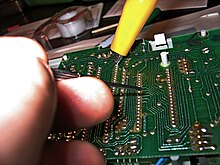Circuit bending
This article possibly contains original research. (May 2008) |

Circuit bending is the creative customization of the circuits within electronic devices such as children's toys and digital synthesizers to create new musical or visual instruments and sound generators. Circuit bending is manipulating a circuit to get an output that was not intended by the manufacturer.[1]
Emphasizing spontaneity and randomness, the techniques of circuit bending have been commonly associated with noise music, though many more conventional contemporary musicians and musical groups have been known to experiment with "bent" instruments. Circuit bending usually involves dismantling the machine and adding components such as switches and potentiometers that alter the circuit.
Experimental process
[edit]This section needs additional citations for verification. (June 2019) |


The process of circuit bending involves experimenting with inexpensive second-hand electronics that produce sounds, such as toys, keyboards, drum machines, and electronic learning products.[1]

Innovators
[edit]While Ghazala says that he was not the first circuit bender, he coined the term Circuit Bending in 1992.[2]
Serge Tcherepnin, designer of the Serge modular synthesizers, discussed[3] his early experiments in the 1950s, with the transistor radio, in which he found sensitive circuit points in those simple electronic devices and brought them out to "body contacts" on the plastic chassis. Prior to Mark's and Reed's experiments other pioneers also explored the body-contact idea, one of the earliest being Thaddeus Cahill (1897) whose telharmonium, it is reported, was also touch-sensitive.
Since 1984, Swiss duo Voice Crack created music by manipulating common electronic devices in a practice they termed "cracked everyday electronics".[4]
See also
[edit]
- Atari Punk Console
- Chiptunes
- Data bending
- Electronic art music
- Glitch (music)
- Glitching
- Kraakdoos (CrackleBox)
- MIDIbox
- MOS Technology SID
- Music Tech Fest
- NIME
- No-Fi
- Noise music
- List of music software
References
[edit]- ^ a b Mirapaul, Matthew (2004-04-08). "Circuit Benders Unlock the Long Riffs in Short-Circuits". The New York Times. Retrieved 2024-11-09.
- ^ Deahl, Dani (2018-09-14). "Hacking a Furby in the name of music". The Verge. Retrieved 2020-07-11.
- ^ Vail, Mark (2000-03-15). Vintage Synthesizers: Pioneering Designers, Groundbreaking Instruments, Collecting Tips, Mutants of Technology (2.00 ed.). Backbeat Books.
- ^ "YULE 2008". Retrieved 2015-06-03.
Further reading
[edit]- Fernandez, Alexandre Marino; Iazzetta, Fernando. "Circuit-Bending and DIY Culture". Retrieved 2022-01-04.
- Steffan, Philip (2014). "Floppy-Symphonie" (PDF). Bastelprojekt. c't Hacks (in German). Vol. 2014, no. 1. Heise Zeitschriften Verlag. p. 149. Archived (PDF) from the original on 2022-01-01. Retrieved 2022-01-04.
External links
[edit]- oddmusic.com's circuit bending section - Gallery of some of Reed Ghazala's work, facts, history, tutorial, benders guide, tools of the trade and more
- GetLoFi a circuit bending blog with a lot of circuit bending tips and resources
- Interview on Circuit Bending with Igor Amokian Part I
